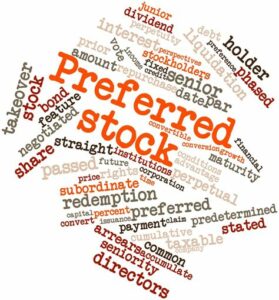Should you buy Common Stock or Preferred Stocks?
What is a Preferred Stock?
Preferred stock is a type of stock that combines features of both equity and debt. It represents ownership in a company, but typically has priority over common stock when it comes to receiving dividends and assets in the event of a company liquidation.
Unlike common stock, preferred stockholders do not usually have voting rights. However, they have the advantage of receiving a fixed dividend payment, which is typically higher than the dividend paid to common stockholders. The dividend payments are usually predetermined and paid out before dividends are paid to common shareholders.
In addition, in the event of a company liquidation, preferred stockholders have priority over common stockholders in receiving their share of the company’s assets.
Preferred stock is a way for investors to receive a fixed income and enjoy some of the benefits of stock ownership while reducing their risk compared to owning common stock.
What are the differences between Common and Preferred Stocks?
There are several key differences between common and preferred stocks:
- Voting Rights: Common stockholders have voting rights and can participate in company decisions such as electing the board of directors and voting on corporate policies. Preferred stockholders typically do not have voting rights, although some preferred stock may allow them to vote on certain matters.
- Dividend Payments: Common stockholders receive dividends when the company declares them, but the amount is not fixed and may fluctuate. Preferred stockholders usually receive fixed dividend payments, which are often higher than those paid to common stockholders.
- Priority in Asset Distribution: In the event of liquidation or bankruptcy, preferred stockholders have a higher priority in receiving assets from the company than common stockholders. Common stockholders are last in line to receive assets, and may not receive anything if all debts and obligations to creditors and preferred stockholders have been fulfilled.
- Risk and Return: Common stockholders generally face higher risk, but also have the potential for higher returns. Preferred stockholders have lower risk, but also lower potential returns.
- Convertibility: Some preferred stocks are convertible into common stock, which allows investors to participate in any potential increase in the value of the company’s shares. Common stock cannot be converted into preferred stock.
Common stock offers more potential for capital appreciation and voting rights, while preferred stock offers more stability and income through fixed dividends. Investors should carefully consider their investment objectives, risk tolerance, and investment time horizon before choosing which type of stock to invest in.
Is a Preferred stock safer than a Common Stock?
Preferred stock is generally considered to be safer than common stock because it typically has a fixed dividend payment and a higher priority in receiving assets in the event of a company liquidation. Preferred stockholders also have lower risk compared to common stockholders because they are paid out before common stockholders in the event of financial distress.
However, preferred stock is still considered to be a form of equity, meaning that it is subject to market fluctuations and other risks associated with owning stocks. The value of preferred stock can still fluctuate based on changes in interest rates, the financial performance of the issuing company, and other factors.
Additionally, preferred stockholders may not have voting rights, which means they may not have a say in the company’s decisions. This lack of control can be a disadvantage for some investors.
What is better for a retirement account, Preferred or Common Stock?
The decision to invest in preferred or common stock for a retirement account depends on several factors, including an investor’s investment goals, risk tolerance, and time horizon.
Preferred stock is generally considered to be less risky than common stock because it has a fixed dividend payment and a higher priority in receiving assets in the event of a company liquidation. This stability can make it an attractive investment for retirees who are seeking a reliable source of income.
On the other hand, common stock has the potential for higher returns, which can be beneficial for investors who have a longer time horizon and are willing to tolerate greater volatility in their investment portfolio.
Ultimately, the decision to invest in preferred or common stock for a retirement account will depend on an investor’s specific investment objectives and risk tolerance. It is important to carefully evaluate the characteristics of each type of stock, including dividend payments, voting rights, and priority in asset distribution, before making an investment decision. Additionally, investors should consult with a financial advisor who can provide personalized advice based on their individual needs and circumstances.
Are Preferred Stocks less volatile than Common Stocks?
Preferred stocks are generally less volatile than common stocks, but this can depend on the specific characteristics of the stock and the issuing company.
Preferred stocks typically have a fixed dividend payment and a higher priority in receiving assets in the event of a company liquidation, which can make them less risky than common stocks. They are also less sensitive to changes in interest rates, which can affect the value of common stocks.
However, preferred stocks can still be subject to market fluctuations and other risks associated with owning stocks. For example, if the issuing company experiences financial difficulties or its credit rating is downgraded, the value of the preferred stock may decline.
Overall, while preferred stocks are generally considered to be less volatile than common stocks, investors should carefully evaluate the specific characteristics of the preferred stock and the issuing company before making an investment decision. Additionally, investors should consider their investment objectives, risk tolerance, and time horizon when deciding whether to invest in preferred or common stocks.


